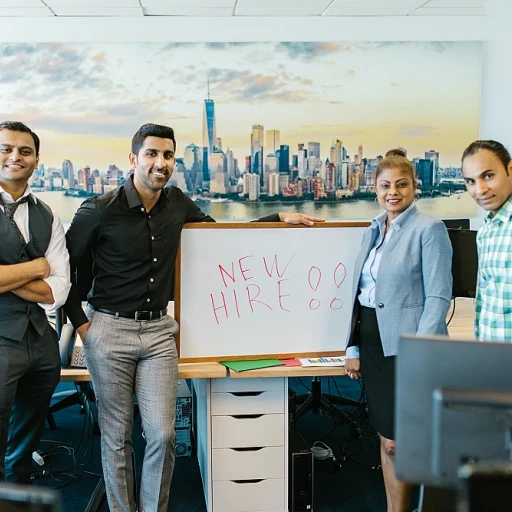Defining employer branding and corporate branding
What is employer branding?
Employer branding is about how a company positions itself as a great place to work. It involves all the efforts that an organization makes to attract, engage, and retain top talent. According to a CareerArc survey, around 86% of job seekers research company reviews and ratings to decide where to apply. Building an attractive employer brand is not just about listing perks and benefits, but about showcasing values, culture, and what makes the workplace unique.
Research by LinkedIn shows that 72% of recruiting leaders worldwide agree that a strong employer brand significantly impacts hiring. This is corroborated by companies like Google and Salesforce, known for their magnetic work environments and strong corporate cultures, making them attractive to job seekers.
The role of employer branding in attracting talent
Making a company irresistible to top talent
Think back to when you were job hunting. What drew you to a job post? Was it the catchy tagline or the impressive perks? That's the magic of employer branding. According to LinkedIn's Global Talent Trends report, 75% of job seekers consider an employer's brand before even applying. It's not just about the paycheck anymore—culture, values, and work environment matter a lot.
Numbers don't lie: the power of employer brand
Companies with positive employer brands receive 50% more qualified applicants, as reported by Glassdoor. Additionally, those with a strong employer brand can reduce the cost per hire by up to 50%. Now, that's some serious savings!
What the experts say
Universum's annual global survey indicates that career advancement opportunities, work-life balance, and respect for employees are top priorities for job seekers. William Tincup, President of RecruitingDaily, says, "Employer branding is about creating a perception of what it's like to work at your company. If done correctly, it can magnetically draw top talent."
Case study: google's employer branding success
Google is often cited as the gold standard in employer branding. Google's extensive benefits, innovative culture, and commitment to employee growth make it a go-to choice for job seekers. A Harvard Business Review study revealed that employee satisfaction and productivity at Google are among the highest, owing largely to its stellar employer branding.
Controlling the narrative
Employer branding isn't just about broadcasting your company's positive aspects. It involves managing your reputation on platforms like Glassdoor and LinkedIn. Negative reviews? Address them head-on. Transparency and responsiveness can turn a potential deal-breaker into a win. According to a CareerArc study, 64% of candidates say they'll avoid applying to companies with negative reviews.
Strategies that work
Start by defining what makes your company unique. Is it the collaborative atmosphere, the professional growth opportunities, or perhaps the innovative projects? Build your brand narrative around these unique points. Engage with your current employees; their testimonials add real value. Utilize social media to share behind-the-scenes looks and employee stories. Involving management in the branding strategy also strengthens the company's image.
Corporate branding's impact on market presence
Connecting with your audience
When it comes to corporate branding, one powerful factor is how well a company can connect with its audience. This connection can be demonstrated through various means such as compelling storytelling and consistent messaging. According to a recent study by Harvard Business Review, 64% of consumers say that shared values help them create a strong relationship with a brand.
Financial metrics and market success
Corporate branding directly impacts a company's market presence by influencing financial metrics. For instance, Interbrand's annual report on the most valuable global brands highlights how strong corporate brands often outperform in the stock market. Companies such as Apple and Google, renowned for their robust branding, continue to lead with significant market shares.
Boosting competitive edge
A strategic corporate brand doesn't just attract customers; it also establishes a competitive edge. Take Nike as an example. Their 'Just Do It' campaign has transcended advertising and become an inspiring call to action for millions. Strategically built corporate brands like Nike set themselves apart in the marketplace and cultivate customer loyalty over time.
Expert insights
According to branding expert Marty Neumeier, “A brand is not what you say it is. It's what they say it is.” This perspective underscores the importance of audience perception in building a strong market presence. Companies must focus on delivering on their brand promise consistently to make a lasting impact.
Case studies in market presence
Look at Tesla's approach to corporate branding. The company has positioned itself as a leader in innovation and sustainability, which has translated into massive market success. Their branding emphasizes cutting-edge technology and environmental consciousness, resonating well with their target audience and investors alike. Another classic example is Coca-Cola, whose consistent brand message and visual identity have made it a household name globally.
For more insights on how employer branding shapes a company’s attraction and retention of top talent, feel free to explore more resources.
Key differences between employer and corporate branding
Understanding the distinction between employer branding and corporate branding
While it's tempting to lump employer branding and corporate branding together, they've got their own vibes and goals that set them apart.
Employer branding is all about how a company is seen as a workplace, while corporate branding focuses on the perception of the company as a whole. Employer branding hones in on attracting talent with a great work culture, benefits, and growth opportunities. Corporate branding is about the wider market presence, reputation, and customer perception. It's a different ball game.
Employer branding's main goal is to attract and retain top talent. This includes showcasing an inclusive, positive work culture and highlighting employee experiences. Just imagine a potential hire scrolling through LinkedIn and seeing awesome stories from current employees. That's powerful stuff. In a LinkedIn study, 59% of hiring managers said employer branding is a significant factor in attracting top candidates.
Corporate branding, on the other hand, is broader and more about market perception. It's how customers see your brand and what makes them choose you over competitors. Think of Apple or Nike. You think innovation or athletics, right? That’s corporate branding doing its magic. It’s about trust, reliability, and the overall vibe customers get when they interact with the brand.
Another key difference is the audience. For employer branding, the audience is current and potential employees. It's personal and more about human connection. But in corporate branding, the audience is wider: customers, investors, partners, and even the general public.
Interestingly, some companies mess this up by blending them too much. They push a strong corporate brand but forget the importance of their employer brand. What's the result? They might attract customers, but struggle to bring in and keep the best talent. A huge dilemma in today's job market.
For instance, Google has nailed both. Their employer brand is all about innovation, flexibility, and growth, which pulls in top talent like a magnet. Their corporate brand? Tech giant, reliable, cutting-edge. And the merger of these two creates a powerhouse brand that's trusted by both employees and customers.
Employer branding's influence on employee retention
How workplace culture fosters commitment
Workplace culture is a significant factor in employee retention. According to a survey by Glassdoor, 77% of adults would consider a company's culture before applying for a job there, reflecting its critical role in the overall employer brand. Companies with established employer branding strategies often experience lower turnover rates. For example, HubSpot, recognized for its strong company culture, boasts a 32% lower attrition rate compared to the industry average.
Recognition and rewards: catalysts for loyalty
Providing recognition and rewards is another aspect where employer branding directly affects retention. Gallup research indicates that employees who do not feel adequately recognized are twice as likely to say they will quit within the next year. On the flip side, employers like Google, which are known for their comprehensive recognition programs, enjoy high employee satisfaction and retention rates.
Leadership and communication loop
Leaders play a vital role in shaping the employer brand and, consequently, employee retention. A study by the Center for Creative Leadership found that 79% of employees who quit their jobs cite lack of appreciation as a key reason. Open and transparent communication from leadership can greatly enhance employee satisfaction and loyalty.
Focus on work-life balance
Flexible work arrangements are increasingly becoming a non-negotiable factor for employees. LinkedIn's 2022 Global Talent Trends report highlighted that 64% of professionals said work-life balance directly influences their decision to stay or leave a job. Companies that prioritize work-life balance are more attractive to prospective and current employees. For instance, Salesforce attributes part of its low turnover rate to its strong emphasis on employee well-being.
Corporate branding and customer loyalty
Building trust through consistent messaging
The ways you present your company to the outside world are important for market success. Corporate branding isn't just about a snazzy logo or a catchy tagline; it’s about building trust. According to Edelman’s Trust Barometer, 81% of consumers say that trusting a brand is a deal-breaker or a deciding factor in their purchase decision. Imagine that – over eight out of ten folks might not even consider your product if they don't trust your brand! Consistency is key here. James Surowiecki, a noted journalist, emphasizes, “Trust is not easily built. It’s a function of consistent messaging over time.” So, every ad campaign, every press release, and even the tweets from your corporate handle should echo the same core values.The role of customer experiences
Think of Apple and how each product launch is an event in itself. This isn't by accident. Research by Walker Info suggests that by 2020, customer experience has overtaken price and product as the key brand differentiator. Apple’s loyal fanbase is built on unforgettable experiences. Whether it's the unveiling of a new iPhone or the service you get at an Apple Store, customer engagement drives market presence.Corporate social responsibility (csr) and its market impact
The younger generation of consumers are not just looking for quality products; they are increasingly aware of brands' ethical practices. Forbes recently reported that 88% of consumers want brands to help them be more environmentally friendly and ethical. Take Patagonia as an example; its commitment to environmental ethics has not only bolstered its brand presence but also driven its financial success. The company’s ‘Worn Wear’ campaign encourages customers to buy used gear and apparel, aligning corporate actions with societal values.Leveraging influencer partnerships
In today’s digital age, influencers have become powerful advocates for brands. According to Influencer Marketing Hub, the average earned media value per $1 spent on influencer marketing is $5.78. This goes to show that partnering with the right influencers can substantially extend your brand’s reach. A classic case is Nike’s collaboration with sports icons like LeBron James and Serena Williams, which has immensely helped in elevating its market presence. These aren't just sponsorships; they are strategic partnerships that convey trust and authenticity.Case studies: effective corporate branding
Let’s talk some real-life success stories that can offer insights. Starbucks has skillfully built an image associated with quality and social responsibility. Through initiatives like ethically sourcing coffee and supporting community building efforts, Starbucks has cemented its market presence. Another fine example is Tesla. Under Elon Musk's leadership, Tesla has made innovation its brand’s cornerstone. They aren't just selling cars; they’re selling a vision for a future with sustainable energy. Revenue reports and customer loyalty surveys consistently show Tesla as a market leader, thanks to its solid corporate branding.Fact-driven corporate branding strategies not only help a company carve out a significant market share but also build lasting relationships with customers. The trust and loyalty garnered through consistent brand messaging, stellar customer experiences, and responsible business practices are often reflected in the company’s sustained market presence and growth statistics.
Successful employer branding strategies
What drives a winning employer brand
Creating an outstanding employer brand isn't just about having a fancy logo or a catchy tagline. It's about truly connecting with potential and existing employees and understanding what they value the most. Research indicates that up to 78% of job seekers consider a company's reputation before applying for a job. That's huge, right? But how do you build that kind of reputation?
Engage authentically, build trust
No one likes a fake. Authenticity is key. According to Simon Barrow, coiner of the term 'employer brand,' the foundation lies in transparent communication and honest marketing. Potential employees are sharp; they can easily spot discrepancies between what a company promises and what it actually offers. For instance, Glassdoor found that 84% of employees would consider leaving their job if a company's values didn't align with their own. Building trust, then, is non-negotiable.
Employee testimonials and success stories
Nothing speaks louder than experiences shared by current employees. When employees share their positive experiences, it really resonates. A report by Edelman Trust Barometer states that 'employees' voices are three times more credible than the CEO's corporate messaging.' Think of LinkedIn posts or blog features where employees share their success stories, learnings, or company culture highlights.
Fostering a positive workplace culture
A positive work culture is another huge factor. Gallup's research shows that companies with highly engaged workforces outperform their peers by 147% in earnings per share. Companies like Google and Zappos are often highlighted for their exceptional work culture, demonstrating that when employees are happy, productivity and commitment follow suit.
Continuous growth opportunities
Nobody wants to feel stuck in their career. Offering continuous learning and growth opportunities is essential for a winning employer brand. According to a LinkedIn Workplace Learning Report, 94% of employees said that they would stay at a company longer if it invested in their learning and development. Training programs, workshops, and clear career paths can make a significant difference.
Integrating employer and corporate branding
Balancing your brand mojo
Picture this: you've got a killer corporate brand that's known for its top-notch products, but your employees are bailing left and right. That's where integrating those employer and corporate branding efforts comes into play, and it's more important than you might think.
First step — a unified message
Organizations often make the mistake of treating employer branding and corporate branding like two separate worlds. But here's the kicker: they are two sides of the same coin. A study by LinkedIn found that 72% of recruiting leaders worldwide agree that employer brand has a significant impact on hiring. If you're not aligning these brand messages, you're shooting yourself in the foot.
Employee advocacy — your secret weapon
Ever notice how some brands have employees that are their biggest cheerleaders? That's not a fluke. Companies like Salesforce have masterfully blended their corporate and employer branding efforts to create an army of brand ambassadors. When your employees believe in your brand, they’ll shout it from the rooftops.
Bridge the gap with corporate social responsibility
Corporate social responsibility (CSR) initiatives can be the glue that holds your employer and corporate branding together. For example, Google's commitment to sustainability and community service not only boosts its corporate image but also attracjobs / *(br=?a=join)), The willingness to +{SEO/brand}. Aligning these initiatives creates a holistic brand story that resonates both inside and outside the company. Studies show that 58% of employees would work for a company with a strong CSR strategy.
Catch inconsistencies early
There's no quicker way to lose trust than to have a mismatch between what you say and what you do. Prospective employees and customers will scrutinize reviews on sites like Glassdoor and social media posts. If your corporate brand advertises a progressive, inclusive culture but your employees say otherwise, you risk alienating both target groups.












